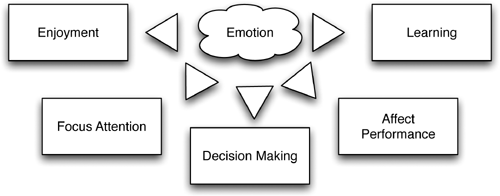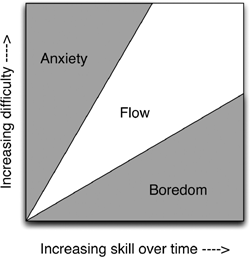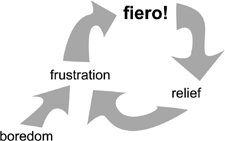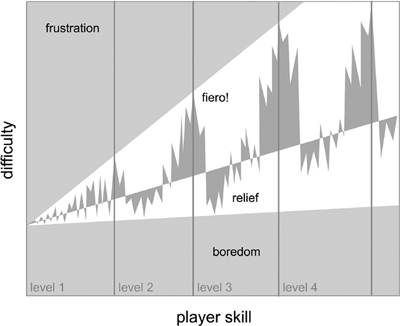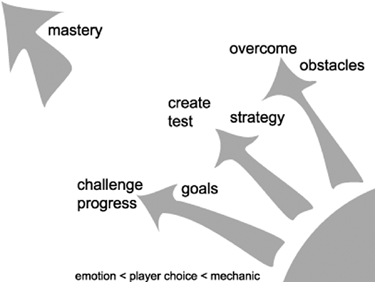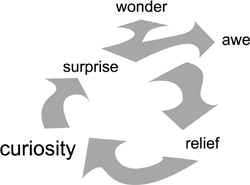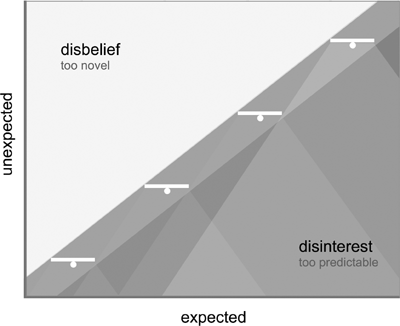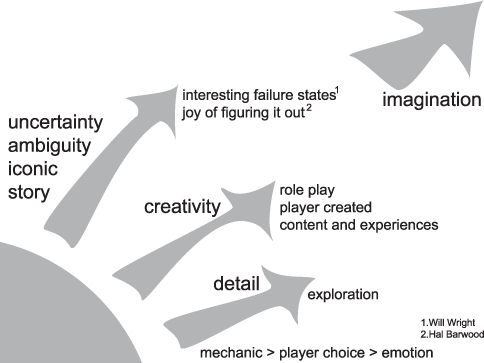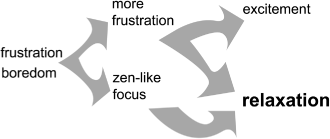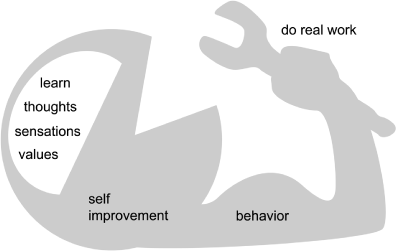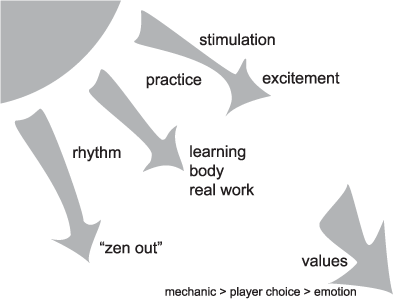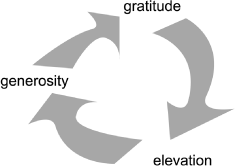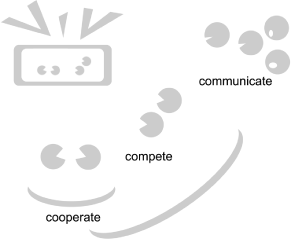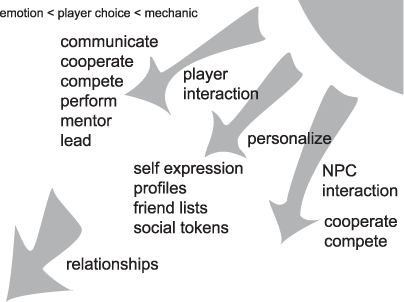Why are videogames fun? What do we even mean when we say “fun”? If you talk to a dozen different players, you will get a dozen different answers. Making sense of the way people respond to the play of a videogame requires some comprehension of player experiences, and one of the best tools for exploring this is Nicole Lazzaro’s “Four Fun Keys” model of player emotions. In this first step, you will learn about the key emotions of play—what they are, how they relate to one another, and what you can do to evoke them in your players.
“Games are a series of interesting choices.” —Sid Meier
The first step to better game design is to understand how to design emotion from gameplay. If games are made of interesting choices, game designers need to know what makes choices interesting to players. This question lies at the heart of all game design, and answering it in new ways is essential for designing games that innovate by exploring new avenues of appeal.
Several factors create player interest. Games create engagement by how they shape attention and motivate action. To focus player attention, games simplify the world, enhance feedback, and suspend negative consequences—this maximizes the effect of emotions coming from player choices. In the simplest terms, game mechanics engage the player by offering choices and providing feedback. Looking at how games rivet player attention and motivate action unlocks many secrets you can use to create better gameplay.
What separates good game mechanics from the boring ones are how gripping they are, and how quickly and completely the choices absorb player attention. In other words, good games are measured by how well they create an emotional response in the player. Because the process of focusing attention and motivating action involves emotions, games that offer more than one type of engagement sustain player interest longer. The interplay between player actions, choices, and feedback from the game creates the series of internal sensations called Player Experience (PX). Strong PX creates engagement or grabs player attention and motivation to play. How games unlock this potential is the key to designing more engaging play.
Effective gameplay requires ease of use so that players can access the inherent fun from play. For a game to be great, players must not only know what to do (know how to drive a car in a driving game, for instance), they also must easily discover opportunities for play (find entertaining things to do with the car in a driving game). Player experiences must create player emotions and engagement. As the practice of improving the quality of games matures, it becomes clearer that the goals and expectations people have for games are very different from their goals and expectations for other software. I often see games in development for which players know how to play but not how to have fun. There are two distinct challenges here. Making what to do too obvious removes all the challenge. Make the game world too open-ended, perhaps by offering too many choices, and players get lost in the decision-making process and fail to have fun. In games the “how to have fun” problem is often harder to solve than teaching players how to play. The practice of making games more fun must identify and balance those issues that relate to making choices, or usability, and those that relate to what makes those choices interesting, the fun factor. To differentiate usability issues from fun factor ones, I use the terms user experience (UX) and player experience (PX), which are defined as follows:
UX: The experience of use; that is how accessible the game controls are and how easily players can accomplish what they expect.
PX: The experience of play; that is, how well the game supports and provides the type of fun players want to have—players cannot simply push a button and feel that they won.
Put even more simply, for UX, researchers look at what prevents the ability to play. For PX, researchers look for what prevents players from having fun. To test games for accessibility and fun factors, the first step is to divide the features into these two buckets, and then apply different techniques to measure and improve the quality of each. Comparing user and player experiences reveals competing purposes, each striving to fulfill very different values, as depicted in the following table [Lazzaro04a].
UX Usability Goals: Productivity | PX Game Goals: Entertainment |
|---|---|
Task completion | Entertainment |
Eliminate errors | Fun to beat obstacles |
External reward | Intrinsic reward |
Outcome-based rewards | Process is its own reward |
Intuitive | New things to learn |
Reduce workload | Increase workload |
Assumes technology needs to be humanized | Assumes humans enjoy being challenged |
User experiences and player experiences require cooperation, much like the two wheels on a bicycle. One wheel connects to the drive chain to make the bike go (UX), and the other wheel steers and creates the fun (PX). The practice of improving software has only identified a few spokes (methods) on that rear UX wheel: heuristic evaluation, time on task, reducing error rates, satisfaction surveys, certain ethnography such as contextual inquiry, and so on. All of these improve interface design and the quality of the user experience, but none of these usability-related practices increases the fun factor or addresses specific emotions, aside from reducing player frustration to increase feelings of “satisfaction” without a precise definition of what this emotion is.
Taken to an extreme, a system that is 100% usable has few errors and requires little effort, but such a system risks boring people by making a task too routine. Also, it does nothing to increase a person’s sense of accomplishment from a job well done, or from mastering a complex task. User experience design alone is not enough to improve all aspects of interactive experiences humans enjoy at work or at play. Player experience design’s main focus is to enhance the emotions coming from play, and this is a comparatively young field. When I began work in this area, there were very few practices to improve a game’s PX—in fact there was no term for the experiences that games create at all! [Lazzaro04b]
“The desire to experience or not experience an emotion motivates much of our behavior.” —Paul Ekman
Emotions play a central role in all player experiences, not only because they add enjoyment, but also because emotions play an important role in decision making. While a good movie or book may make people laugh and cry, the neuroscience research of the past 10 years has revealed that emotions are not just for entertainment.
By definition, emotions are internal sensations that occur in relationship to pursuing a goal. Psychologists use this definition to separate emotions from other internal sensations such as hunger, pain, and sleepiness. Paradoxically, damage to the emotional system severely hampers a person’s ability to make decisions! This vital link between emotion and pursuit of a goal makes emotions key to the design of engaging gameplay.
Because emotions relate directly to a person’s goals, they are always involved in player experiences, regardless of whether the designer is aware of this. For instance, one of the top reasons people play games is to alleviate boredom. People play everything from Bejeweled (PopCap, 2001) to Counter-Strike (Le and Cliffe, 1999) to achieve a sense of calm, to “Zen out,” or to feel more excited. They may also play to relieve unpleasant emotions, such as frustration—many players use a videogame to alleviate their work stress when they get home.
Game designers cannot design emotions directly. Instead they design “the rules in the box” that offer player choices. Emotions emerge principally from the process of making choices an idea, which is expressed in Figure 1.1 (although of course, emotions can also happen as visceral responses to other aspects of a videogame, such as sound and animations). The tight coupling of motivation and emotions makes designing emotional responses a crucial tool for game designers.
The relationship between game mechanics and player emotions has several factors that can increase engagement. Often, poorly pairing a choice and the surrounding emotions decreases engagement. In exploring and tuning this relationship there are several factors to consider. Regardless of a game designer’s intentions, emotions result from all gameplay, because the factors that create engagement are emotional responses.
Emotions play five distinct roles in increasing player engagement with a game [Lazzaro07], as illustrated in Figure 1.2.
Enjoyment: Players enjoy the sensations that emotions create.
Focus Attention: Emotions affect the player’s focus. For example, a boiling lava pit captures player’s attention more than a city sidewalk.
Decision Making: Emotions aid in making decisions. People without emotional systems can logically compare the consequences of two options but cannot make the choice itself. For example, in Tom Clancy’s Splinter Cell (Ubisoft Montreal, 2002), the choice between certain death and escape via a narrow window ledge is easier to make than selecting a door in an empty office corridor.
Performance: The negative emotions in Battlefield 2: Modern Combat (Digital Illusions, 2005) facilitate the type of repetitive behavior the game rewards—shoot the sniper and move on—whereas the positive emotions from Katamari Damacy (Namco, 2004) inspire creativity and problem solving by helping the player figures out how to roll their little sticky balls from the floor up onto a table.
Learning: Finally, emotions reward and motivate learning, as all games teach.
Notice how the role of emotion in player engagement utilizes both positive and negative emotions—game designers need to be aware of the emotional carrot, and the emotional stick, not to mention other emotions that shape attention and facilitate different forms of action, ranging from the intellectual curiosity that drives players to figure out a clue in Half-Life, to the desire to help a friend learn to control the vehicles in Mario Kart.
It is ironic that the important role of emotions in human decision making and entertainment has taken so long to be recognized by game designers. Before I published my research in 2004, the common belief was that improving the graphics, building faster processors, and adding features to last year’s best sellers was the way to create better games. There continues to be a lot of talk about creating “addicting” games. Many in the industry want their games to be as “addictive” as possible. There are significant limitations to this one-dimensional way of increasing engagement, because non-gamers who’ve had perfect access to games (for instance, someone living with a gamer) often avoid games precisely because they feel they are too addictive.
Back in 2000, my colleagues and I wanted to know what created engagement beyond loops of “stimulus, response, intermittent rewards” which many people use to design game “addiction” (and which you will learn more about in Step 3). I knew that there were healthier alternatives out there for creating engagement and a broader pallet of emotions being evoked in players, but I needed a deeper understanding of the psychology of play in order to discover what would appeal to a wider audience. You can’t make better games without first understanding what players enjoy the most about games, and to do this you need to know the PX players really want.
Because emotions are hard to see, the important role that they play in videogames was not widely recognized prior to my research. Whether or not “games can make you cry” was a lively debate for many years, since many people felt that games could only create the emotions of the sports arena. The starring role that emotions play in game mechanics was not widely understood.
Research was needed, and it needed to begin with externally, independently observable emotions, because emotions are fleeting and players frequently are either unaware of them, or often cannot remember experiencing them. This was the reason my qualitative research began by looking at emotion on players’ faces as they played videogames, identifying the emotions they were experiencing as they were happening. This research was made possible by pioneering work conducted by one of the leading psychologists in the field of emotions.
Paul Ekman has done more to map out the human emotional terrain than almost any other researcher, especially in respect to facial expressions. Over the space of 40 years, he and his colleagues researched the muscles of the face and how they related to specific emotions. Similar to identifying the basic colors that everyone can see, they wanted to identify the basic emotions that all human beings feel [Ekman03].
Building on the work of the 19th century French researcher, Guillaume Duchenne, Ekman and his colleagues stimulated facial muscles individually in order to build a detailed map of all the muscles of the human face. This allowed Ekman to create what he termed a Facial Action Coding System (FACS), where each muscle has its own number. Using FACS, Ekman and his colleagues explored which muscles were involved in the facial expression of different emotions. It transpired that of all the potential combinations of muscles that could be used, only a small fraction is involved in producing the recognizable facial expressions associated with particular emotions.
This was already impressive work, but to be certain these facial expressions mapped to emotions across cultures, Ekman took this remarkable work even further. By using photos of different facial expressions, he and his researchers conducted studies in cities and towns in numerous countries around the world to discover which emotions had universally recognizable facial expressions. In these studies, researchers would tell a short story such as the loss of a child, or being asked to eat rotten food, and then ask the participant which of two facial expressions matched how someone in that situation would feel.
To ensure the facial expressions were truly universal and not just the result of watching television or movies, the researchers studied people around the world including the indigenous people of Papua New Guinea living in a traditional culture practicing subsistence-based agriculture who had no access to mass media.
This research contradicted the prevailing belief of anthropologists at the time that emotions were culturally determined. Ekman honed in on six key emotions that have facial expressions that are universally recognized by human cultures wherever they are in the world: happiness, anger, sadness, surprise, fear, and disgust. Table 1.1 summarizes these emotions. In later research, he expands the list of emotions to include emotions without unique facial expressions. There was such a variety of emotions that in naming them Ekman had to borrow words from various languages!
Table 1.1. Six Plus One Emotions with Universal Facial Gestures
Emotion | Game Example |
|---|---|
Frustration (Anger) | Figuring out how to get a character off a roof in Splinter Cell (and created by usability issues that detract from the player’s ability to play). |
Fear | Falling into boiling lava, fast-moving projectiles aimed at the player in Doom (id Software, 1993). |
Surprise | Using the linking books in Myst (Cyan Worlds, 1993) for the first time to transport to a new world. This is often followed by wonder. |
Sadness | When the young magician Aerith in Final Fantasy VII (Square, 1997) is murdered. |
Amusement (Happiness) | When two Sims get married in The Sims (Maxis, 2000), or rolling over and picking up sumo wrestlers in Katamari Damacy. |
Disgust | Becoming a social outcast (social disgust) after losing the dancing challenge in Sid Meier’s Pirates! (Microprose, 1997). This moment also creates contempt. |
Curiosity[*] | Wanting to know what happens by driving the race track the wrong way in Project Gotham Racing (Bizarre Creations, 2001). |
[*] Not all researchers (including Ekman) considered curiosity a universal emotion with a unique facial gesture. I include it here as a seventh emotion because of its importance in games and ease of observation. | |
At first appearance players may seem emotionally detached during play—they may not be articulate, remember, or even be aware of the emotions they feel. Despite this, emotions have a vital role in creating that deep sense of engagement which is characteristic of highly enjoyable play. Watching players as they interacted with videogames, there was no doubt that the emotions were there—it was literally written all over their faces! Furthermore, careful observation revealed small facial movements (which Ekman calls micro expressions), that could be seen while players were doing what they enjoyed the most during play. Lasting barely a quarter of a second, these movements provide clues to changes in the players’ mental state around choices they make.
FACS provided a means to measure the emotions expressed on the face during play, but as my colleagues and I were conducting this research it became clear that many emotions connected with players’ favorite moments were not observable in this way. It became apparent that it was necessary to examine changes in the body as well as the face, to listen for sounds (such as laughter), and to watch which muscles were in use. Plus there were some emotions that were not included by Ekman, such as curiosity—a facial expression that can be recognized early in child development—which served an important role in play.
There were also some emotions that Ekman had identified that were peripheral to his work on facial expressions, but that were much more important in the context of videogames. One such emotion is fiero (an Italian word meaning personal triumph over adversity), which turns out to be intimately associated with games and sports. Everyone who has ever beaten a boss monster or won a Grand Prix race has felt this emotion, which produces a response in the whole body—the raising of the arms, punching the air, or jumping up from their chair. Some players and game designers even mistakenly think of this as the only important kind of fun associated with videogames. It is ironic that this emotion had no name in game design until this research on emotions and games made the need for a precise term clear.
Players feel emotions before, during, and after decisions. Nearly all decisions require the cognitive and emotional systems, but despite this, there is a tendency for game designers to employ just a fraction of the emotional tools available to them. For example, when the videogames industry first began to explore 3D representations, games filled themselves with situations and choices designed to increase anger, fear, and disgust, such as realistic blood splatters and boiling lava monsters, and choices like shooting and blowing things up. As you will shortly discover, there are many other emotions evoked by games, and designers who understand how to engage player emotions have a serious advantage when it comes to innovating new game ideas. First, however, you need to learn a little more about what happens when a game captures the player’s attention.
Emotion is not the whole story of player enjoyment: gamers also love the deep sense of engagement they get when they play. More of a state of being than an emotion, “engaging activities” absorb attention and are self-motivating. The games that players enjoy the most are those that facilitate this self-motivating engagement, games in which the choices players make are rewarding in and of themselves. Examining the types of choices and emotions that go with these deep play experiences unlocks many secrets of how to create engagement.
The most influential psychologist working in the field of engagement is Mihály Csíkszentmihályi (pronounced “chick-sent-me-high-ee”). He was fascinated by what created optimal experiences—those that people remember most vividly, and that they prefer over other experiences. He conducted a series of detailed field studies that asked people to recall which moments in their lives were the most engaging. To increase the accuracy of his research, and to aid in catching his subjects when they were “in the moment,” Csíkszentmihályi arranged for people to carry pagers that beeped them at random times during the day. The participants in this study would note in a journal any relevant details, such as what they were doing, their level of engagement, and the pertinent qualities of the particular activity.
Surprisingly, the moments that people enjoyed the most were not relaxing poolside vacations, but rather activities that required considerable effort such as rock climbing, dancing, gardening, and talking with friends. These activities call for significant mental investment and concentration, and provided opportunities for personal growth. Additionally, Csíkszentmihályi discovered that to maintain this deep sense of concentration these activities required clear goals and a perfect balance between skill and difficulty. Whether it was a woman gardening in Kentucky or a Japanese teen in a motorcycle gang racing through the streets of Tokyo, all of these disparate experiences had similar characteristics. Without a sufficient degree of challenge, people disengage and activities quickly become routine and boring. With too much challenge, a person becomes frustrated, suffers anxiety, and ultimately quits.
The concept from Csíkszentmihályi’s research with the greatest relevance to game design is his model for Flow. Lasting much longer than Ekman’s definition of an emotion, and having deep cognitive and behavioral properties, Flow engrosses a person in an activity. According to Csíkszentmihályi, optimal experiences are those where the person is balanced between the challenges they face and the skills they have acquired. He termed this the Flow Channel, the path between anxiety (too difficult) and boredom (too easy), as depicted in Figure 1.3 [Csíkszentmihályi90].
Furthermore, Csíkszentmihályi found that people generally required that the level of difficulty increase over time (to avoid boredom as their skills improved) and often expressed greater enjoyment of these activities afterwards, upon reflection, than they did in the moment.
From this research Csíkszentmihályi created the Flow model, which characterizes people’s optimal experiences. More of a state of being than an emotion, Flow creates a deep sense of engagement where a person’s mind is filled by an activity that has an optimal balance of skill and difficulty. The activity increases in difficulty as the activity progresses. As a person’s performance gets better, there is a sense of growth and improvement. Doesn’t this sound like a game?
The best way to understand how Flow creates engagement is to watch it in action. The conditions for the mental state of Flow are present in the design of most popular computer games, such as Tetris (Alexey Pajitnov, 1985), which create enjoyment from difficulty. One of the world’s most popular games, Tetris captures attention with its simple rules and balance of difficulty with player skill. The game provides clear goals and plenty of feedback. The game rotates blocks in response to player input, and these blocks lock into place in a satisfying way. As complete rows are built, blocks get cleared with sound effects and animations. Like Bejeweled, all of these aspects work together to create a deeply engaging player experience.
Csíkszentmihályi identifies a number of requirements for the Flow state, and these can easily be applied to Tetris:
Clear Goal: Position blocks in a row to clear them before the stack reaches the top
Achievable Tasks: Position blocks one at a time
Immediate Feedback: Indicate effect of controls (turn block), and show progress clearly (lines disappear)
Sense of Control: Feedback creates satisfaction from success and “putting things in their place”
Increase in Difficulty: The game gets harder (blocks appear and fall more rapidly) as the player progresses
What Csíkszentmihályi describes as Flow clearly applies to player experiences. Flow characterizes a deep state of engagement and personal growth very similar to what gamers describe as being one of their favorite aspects of videogames. In addition to this, relief from negative emotions (such as the frustrations of everyday life) during game activities constitutes a major reason why people play.
Paradoxically, game players often characterize gameplay by how emotions vanish as they “get into the zone.” And watching players this often appears to be true, at least at first glance. However, by watching closely for micro expressions, you can see that players clearly demonstrate emotional states connected to the choices that they make in games. Therefore, when playing their favorite games, players often cycle between states of deep engagement punctuated by powerful emotional moments. Csíkszentmihályi’s Flow model is an excellent start for describing some of the engagement factors that games create. However, a more complete model of emotion and mechanics would capture more types of engagement seen in players’ favorite experiences and thus give designers more tools to craft new kinds of gameplay.
My experiences of observing players demonstrated there were several aspects of player behavior not predicted by Csíkszentmihályi’s model for Flow. Truly absorbing gameplay requires more than a balance of difficulty and skill. Players leave games for other reasons than over-exertion or lack of challenge. In players’ favorite games, the degree of difficulty rises and falls, power ups and bonuses make challenges more interesting, and the opportunity for strategy increases engagement. The progression of challenges to beat a boss monster and the drop of challenge at the start of the next level help keep players engaged. Intense gameplay may produce frustration when the level of challenge is too high, but it can also produce many different kinds of emotions, such as curiosity or wonder. Furthermore, play can also emerge from decisions wholly unrelated to the game goal.
Additionally players spend a lot of time engaged in other activities such as waving a Wiimote to wiggle their character or create a silly avatar that require no difficulty to complete. Players respond to various things that characterize great gameplay for them, such as reward cycles, the feeling of winning, pacing, emotions from competition and cooperation. But to create great gameplay, designers have to adjust many aspects, not only in difficulty. Players clearly respond and seek out factors outside the Flow model.
Before designing the study on why people play games, my colleagues and I looked at the groundbreaking work done by leading researchers and practitioners from diverse fields such as psychology, filmmaking, and drama about what creates enjoyable product and entertainment experiences, as well as prior research in the fields of play and videogames. Comparing these diverse frameworks provides an interesting perspective on the commonalities of creating human engagement. Most importantly, the majority of the prior research discussed at most one or two emotions, or looked solely at how to create emotions that are “positive” or “negative.”
Perhaps the most relevant models of creating emotional engagement in general (after Csíkszentmihályi) are Tiger and Jordan’s models of how products create pleasure—physio-pleasure, psycho-pleasure, ideo-pleasure, and socio-pleasure [Tiger92], [Jordan00], and Norman and Boorstin’s three sources of engagement—voyeuristic eye, visceral eye, and vicarious eye [Boorstin90], or Norman’s behavioral, cognitive, and reflective layers [Norman04]. However, examining players and the games they preferred showed there was more at work than just whether an emotion during play was positive or negative, or was arousing or relaxing as described in Norman and Boorstin’s models.
There were also models that looked more particularly at software, such as those of Hassenzahl, Platz, Burmester, and Lehner, which consider ergonomic quality versus hedonic quality [Hassenzahl00] or the work of Wright, McCarthy, and Meekison, which considers spatial-temporal, compositional, sensual, and emotional threads, following an earlier conceptualization by John Dewey [Wright03]. However, none of these disparate researchers had mapped out the wide range of emotions that can be seen when people play their favorite games, and none of them broke out different factors for creating engagement from different kinds of choices.
Additionally, there was work that had specifically been conducted in relation to play, such as Jean Piaget’s studies of childhood play and fantasy [Piaget62]. In specific connection with videogames there were pioneering studies such as those by Thomas Malone [Malone81] on the role of challenge, fantasy and curiosity in play (about which you will learn more in Step 3).
Not surprisingly much of the research on videogames had focused on challenge, and only a few recognized the importance of other factors or people during play. A notable exception was the work of Richard Bartle, which highlighted the interdependent roles that players naturally assumed in online worlds, for instance, providing places for players who like to socialize provides an audience for achievers when they return to town to boast about their accomplishments (about which you will learn more from Richard himself in Step 4) [Bartle96], [Bartle03a], [Bartle03b]. There was also additional work on the role of community for web designers by Amy Kim [Kim00], which was interesting and relevant, but narrow in focus compared to the wider goal of learning about emotions of play.
Ultimately, none of these frameworks focused on the creation of specific emotions during play, and none of the preexisting models identified specific game mechanics associated with what gamers most enjoyed about games. Additionally, the creation of visceral engagement and the use of games to change how players feel, or to improve their lives, were all subjects wholly absent from the body of research. This demonstrated a clear need for a model describing the relationship between emotion and gameplay that could ultimately inform game designers how to proceed in the task of refining player experiences.
Given the lack of research on this subject, my colleagues and I resolved to use a simplified version of Paul Ekman’s FACS to identify which emotions were evoked by the games that players enjoyed the most. Watching the emotions on players’ faces would lead to an understanding of how the emotions of play relate to the types of choices that players most enjoyed.
Back in 2000, my colleagues and I at XEODesign were thinking about the types of games we wanted to design, and those we wanted to play ourselves, and it was clear that the videogame industry lacked the language to describe (and the tools to create) new kinds of player experiences. The main focus of the industry thus far has been to perfect a small number of game styles.
For the past 10 years, a trip to the videogame store was like going into a toy store and seeing only six kinds of toys: GI Joe, Risk (Albert Lamorisse, 1957), sports equipment, Hot Wheels, Dungeons and Dragons (TSR, 1974), and a dollhouse (The Sims). Table 1.2 demonstrates how one-sided the market for videogames has been [NPD05]. Unless you were someone who could design intuitively, like Shigeru Miyamoto, Will Wright, or Sid Meier, there were no tools to describe and develop new player experiences that could break out of this cycle of imitation. The recent success of Nintendo’s Wii and DS consoles, the Guitar Hero (Harmonix, 2005) and Rock Band (Harmonix, 2007) franchises, and downloadable casual games such as Diner Dash (gameLab, 2005) provide proof that a larger market exists for games that offer new play styles outside the game genres that dedicated gamers loved, the so-called traditional hardcore gamer market [Lazzaro08a].
Table 1.2. Top-Selling Games Offer a Limited Number of Play Styles
Type | Number of Titles | Percent | Definition | Example Games | ||||
|---|---|---|---|---|---|---|---|---|
Roleplaying and fighting | 31 | 52% | Games where the primary interaction is fighting one-on-one or in small groups with a gun or fists. | World of Warcraft (Blizzard, 2004), Guild Wars (ArenaNet, 2005), Star Wars: Battlefront II (Pandemic, 2005) | ||||
War and strategy | 5 | 8% | Games that simulate warfare where the player manages a whole battlefield of fighters. | Age of Empires (Ensemble, 1997), Sid Meier’s Civilization IV (Firaxis, 2005), Rome: Total War (Creative Assembly, 2004) | ||||
Sports | 9 | 9% | Games that simulate a real-world sport such as basketball or football. | Madden NFL (EA Tiburon, 1988 onwards), NCAA Football (Software Toolworks et. al., 1994 onwards), NBA Live (Hitmen et. al., 1994 onwards) | ||||
Racing | 5 | 5% | Games where players compete by driving or flying. | Gran Turismo series (Polyphony, 1997 onwards), Need for Speed series (Pioneer et. al., 1994 onwards), Mario Kart series (Nintendo, 1992 onwards) | ||||
Other | 10 | 10% | Games where players build or manage people and their relationships or run a business such as a theme park or zoo. | The Sims 2 (Maxis, 2005), Roller Coaster Tycoon (Chris Sawyer Productions, 1999), Zoo Tycoon (Blue Fang, 2005) | ||||
Total | 60 | 100% | ||||||
* Source: NPD 2005 | ||||||||
Table 1.2 clearly demonstrates that over 60% of the best-selling games in 2005 focused on war games and the rest of the market only developed three other themes.
Having watched different emotions on players’ faces for years in our play lab, I was curious how emotions related to a player’s favorite moments in gameplay. Films, for example, have the language of cinema at their disposal—plus industry best practices such as concept statements, treatments, scripts, and story boards—all designed to design films that create more engagement. Without imitating these six common styles of game, what can designers do?
To measure engagement, attention, and motivation, it was necessary to identify the activities that players most enjoyed, and to do this my colleagues and I watched players play their favorite games from Tetris to Halo (Bungee, 2001) at home, school, work, and in the case of mobile games on the go. We interviewed gamers—men and women, young and old—to capture their experiences and enjoyment factors as they played and video-taped their faces so we could measure their emotional responses.
Inspired by Ekman, Csíkszentmihályi, Bartle, and others, our goal was to develop a framework for designing emotions in games based upon the types of choices players most enjoyed. This framework should do three things: target what players like the most about games, be measureable by researchers, and be controllable by designers. In essence, we hacked the “what’s fun” problem from the player’s perspective by looking at which moments in games players liked the most, which emotions they were feeling (by watching their faces), and noted what mechanics were involved. All together, we collected over 2,000 observations from 30 players in our original study and organized them by emotion into four main groups. By looking at the emotion first, we found which types of choices were present during the most engaging moments of play, and noted new relationships between mechanics that shared the same emotional space [Lazzaro 04a].
The manner in which gamers modify the way they play can be extremely informative about the play styles they enjoy the most. Further evidence for the mechanics behind different play styles can be found in the way players often alter the game and the way they play to offer more of a particular kind of fun that matches their mood. For example, players may revisit early levels of a game to wreak mayhem with their now overpowered character, they might use a game to provide a base line of engagement while doing another task (such as playing Civilization on easy mode while talking to a boyfriend on the phone), they might choose to play a game in order to help them resist the temptation to eat a muffin, or they might try to steer their car from the view on an opponent’s screen in order to increase the challenge. The way people modify their play speaks volumes about what they most enjoy about games.
Because game designers cannot design emotions directly, at XEODesign we first identified the moments players liked the most in games and noted which emotions were present. Through cluster analysis, we grouped together the moments that had similar emotions. Then— working backwards from emotion to choice—we identified the four types of game mechanics that engaged players most effectively during play. Some emotions happened in a set sequences, such as curiosity leading to surprise, or amusement leading to social bonding. Grouping players’ favorite mechanics by the emotions they created revealed four distinct play styles. These groupings also showed that players’ favorite mechanics often facilitated the transition from one emotion in a cycle to the next. Further examination of these emotion cycles revealed that, while in best-selling games they often occurred simultaneously, each group of mechanics created different player experiences formed around very distinct styles of play.
The results of this study showed that people play games in essentially four distinct ways, and each of these play styles is associated with a different set of emotions. Players seemed to rotate between three or four different types of choices in the games they enjoyed, and the best-selling games tended to support at least three out of these four play styles. In contrast to the common wisdom of the time, most players didn’t want better graphics, or smarter AI. There were other factors far more important to players [Lazzaro 04c]. Recognizing the importance of delivering new player experiences helped fuel the success of Nintendo’s DS and Wii game consoles.
Some players crave the increased heart rate of excitement from playing Bejeweled in timed mode, the skin-prickling sensation from wonder in Myst, the tension of frustration followed by the thrill of victory in Madden NFL, or the amusing conversation starter from rolling over sumo wrestlers in Katamari Damacy. For others, the draw of videogames was simply the exchange of worries and thought and feelings for relaxation and contentment, or a feeling of achievement from knowing they did it right.
What players liked the most about videogames can be summarized as follows:
The opportunity for challenge and mastery
The inspiration of imagination and fooling around
A ticket to relaxation and getting smarter (the means to change oneself)
An excuse to hang out with friends
The four patterns that came out of this research were called the Four Fun Keys because each play style is a collection of game mechanics that unlocks a different set of player emotions. We found that rather than having one favorite play style, players rotated between any three of the four during a particular play session. Likewise, blockbuster games containing the four play styles outsold competing similar titles that imitated only one kind of fun.
The most obvious play style is the Hard Fun of achieving a goal. Players favoring this Fun Key made comments about their play that focused on the game’s challenge, strategic thinking, and problem solving. This Hard Fun generates emotions and experiences which lead to frustration, and then fiero (the emotion of “triumph over adversity” mentioned previously). Players utilizing this play style make choices in context of a clear goal, some obstacles to overcome, and an aim to make progress enhanced by the feedback delivered from the game. As with Csíkszentmihályi’s concept of Flow, the game designer’s biggest challenge in this style of play is balancing the game’s difficulty with the increases in the player’s skill. If the game remains the same difficulty, players may master the game and quit because they are bored. Conversely, if the game becomes too challenging too quickly, players quit because they become too frustrated. In addition to the level of challenge, the nature of the challenge must also change, because players who enjoy Hard Fun also like developing new goals, strategies, and puzzles to solve.
Aside from challenge, players enjoy intrigue and curiosity. This Easy Fun is the bubble wrap of game design. Players become immersed in the game when it absorbs their complete attention, or when it takes them on an exciting adventure. Curiosity about a mystery, theme, or story holds player attention in a way that focusing on a goal does not. Easy Fun also keeps the challenges from Hard Fun feeling fresh and new. These immersive game aspects are collected under Easy Fun, which generates the emotions and experiences of curiosity, surprise, wonder, and awe.
Additionally, many players enjoy the visceral, behavior, and cognitive experiences that games create. Players enjoying this Serious Fun play for internal sensations such as excitement or relief from their thoughts and feelings. Games become quick and easy escapes, a tool to blow off workplace frustration, and to achieve life goals. Treadmills for the mind, games become therapy and players appreciate games as a way to experience and express their values.
Players also use games as mechanisms for social experiences or—People Fun. These players enjoy the emotions of amusement, schadenfreude (pleasure in other people’s misfortune), and naches (pleasure in the achievements of someone you have helped). These emerge from the social experiences of competition and teamwork, not to mention enjoying opportunities for social bonding and the personal recognition that comes from playing with others. People Fun increases social capital between friends, and creates social tokens, inside jokes, and shared experiences.
That’s not to say that Hard Fun lacks excitement, or players don’t feel curious when playing with their friends. In fact, players’ favorite moments in best-selling games often involve mechanics from all four keys at the same time, and bring all the related emotions with them.
The most surprising aspect of these research findings was the dramatic contrast in emotional displays between one person playing alone versus several people playing together. Players in groups emote more frequently and with more intensity than those playing on their own. Group play adds new behaviors, rituals, and emotions that make games more exciting (you will learn more about social play in Step 2). We were also surprised at how aptly Flow describes challenge in videogames, and the promise this holds for making games that can improve quality of life. For the game designer, the Four Keys to unlocking emotion in moment-to-moment gameplay offer new opportunities for generating emotion through player choice.
“I always know how my husband feels about a game. If he screams ‘I hate it! I hate it! I hate it!’ then I know two things. A) He’s going to finish it. B) He’s going to buy version two. If he doesn’t say these things he will put it down after a couple of hours.” —Wife of a “hardcore” PC gamer
The best understood aspect of videogames, that most clearly separates games from other activities, is the opportunity for challenge and mastery, or Hard Fun. In Hard Fun, players apply themselves to accomplish difficult tasks in the game world. The opportunity to win provides players the Hard Fun of overcoming obstacles and applying themselves. Hard Fun mechanics focus and motivate by requiring skill to complete a goal. For example, basketball would not be as much fun if the hoop were twice as wide and positioned at waist level. Simply pushing a button rarely feels like winning, so instead games challenge the player to achieve more. They are called Hard Fun because these game mechanics reward the player’s hard work.
The dominant emotions from Hard Fun mechanics are frustration and fiero. Fiero, the personal feeling of triumph over adversity, is seen by some designers as the Holy Grail of game design, because fiero is how players feel when they win. There is no word in English for this emotion, so following Ekman’s lead I borrow one from Italian. Players cannot push a button and feel fiero; they must feel frustrated first because fiero is the reward for accomplishing something difficult. It is one of the most powerful and positive human emotions, although the quest to attain it requires considerable frustration!
To provide opportunities to feel fiero, videogames get the players so frustrated that they are almost ready to quit—but just before they quit, they finally succeed. When this happens, there is a huge phase shift in the body and players go from feeling highly frustrated to feeling very good about themselves. Like the denouement after a film’s climax, game designers often reduce the challenge after a game’s climax to enhance the player’s feeling of power, to give players a chance to bask and reflect on their achievement. Unlike films, games provide fiero directly from choices that players make themselves. Games create emotion through developing a sense of player agency rather than empathy with a character on-screen. In other words, a film never hands the audience a jet ski to save the world from nuclear doom, but a game must do so because in games, player choice matters.
Figure 1.4 shows how Hard Fun generates fiero: during play, gamers often start bored, become frustrated with each attempt to overcome the challenge, then experience fiero when they finally achieve the win, before feeling relief that the challenge is complete. Looking for fiero during player testing is a good way to assess the Hard Fun in a game. Seeing fiero from trivial tasks such as being able to finally move a game character is also a great way to identify user experience issues that prevent play.
Videogames create Hard Fun through the use of specific mechanics, or types of choices offered to players. Most importantly, Hard Fun offers the player a goal and a means to accomplish it. As Csíkszentmihályi’s model predicts, for Flow there needs to be a balance between the difficulty of the challenge presented and the skills available to the player to overcome that challenge. Long-term goals need to be broken into achievable steps, either explicitly, or by the strategic thinking of the player. Hard Fun mechanics provide goals, simplify the world, and offer enhanced progress feedback in the form of levels, points, and other achievements.
To maintain player engagement, Hard Fun mechanics must also vary the level of challenge. Games like Doom, 1942 (Capcom, 1984), Golden Axe (Sega, 1989), or God of War (Sony, 2005) offer a series of progressively more difficult enemies to defeat, ending each level with an especially challenging boss foe. Power ups are another tool that games such as Pac-Man (Namco/Midway, 1980) use to break up gameplay during a level, offering the opportunity for fiero in the middle of levels by offering temporary super powers as well as creating new options for changes in strategy. Extra bonuses during play also provide mini fiero-like experiences for players by offering the opportunity to win something mid-level (such as the fruit in Pac-Man). Games such as Diner Dash or Zuma (PopCap, 2003) reward repeat play by offering expert scores and side challenges such as hard-to-reach bonus coins, which keep the fiero flowing.
To keep players “in the zone” over time, games with very open worlds have to find different ways to provide Hard Fun. Virtual worlds such as World of Warcraft often structure challenge in the form of a quest whereby the player must overcome obstacles (such as killing deadly spiders) to earn a reward (such as a new piece of armor). The quest structure makes the goal state explicit to the player, and very large virtual spaces can then easily be populated with opportunities for achieving fiero by stuffing them full of quests. It is important to remember that game design requires more than Hard Fun. To maintain player enthusiasm for questing, World of Warcraft uses mechanics from all four of the Fun Keys.
Hard Fun mechanics increase engagement by requiring players to develop strategies to win. Hard Fun is more than beating more monsters in less time. For example, to earn enough bonus points by matching large groups of colored tiles to clear the level for Collapse! (GameHouse, 1999), a game in the popular casual match 3 genre, players must pool large areas of one color. However, the introduction of a fourth color on level 4 breaks this strategy, thus requiring players to devise a new way to win. Players who enjoy Hard Fun love this!
Figure 1.5 shows how the challenge from the Hard Fun in a hypothetical game varies from level to level. To begin with, the player has little experience with the game, but the game has low difficulty to allow for this. In level 2, the player gets the hang of it, but the game increases the pressure (i.e. more foes, tougher challenges) to make it harder for the players to achieve victory. So when they win this level, they get the payoff of fiero. Level 3 begins with less challenge than the end of level 2, and the feelings of empowerment and relief from clearing the previous level carries players through the easy opening section of play and new experiences create curiosity to keep the game fresh. Then, once again, the challenge ramps up near the end, giving the players the fiero of victory at the end of the level. This pattern repeats over and over again in level-based games featuring Hard Fun.
Often in later gameplay a game without enough Hard Fun feels flat because there are not enough challenges, or one strategy works for all levels. Likewise winning by luck rather than skill reduces players’ sense of agency. A common source of this flatness can be the lack of an opportunity to devise new strategy. While players vary in how spiky and steep they want their play through the Flow Channel to be, in Hard Fun if there are not enough interesting obstacles, fiero is effectively denied. Because to overcome great challenge it is necessary for the player to face great hardship. This can necessitate changing game mechanics over time, not just by increasing the overall difficulty.
Players also look for a progression of new obstacles and the opportunity to develop new strategies as they play. A good rule of thumb is to require new ways to win every four or five levels and integrate new strategy into the rewards for Hard Fun. For example, in Diner Dash, the trophy for winning level four is a coffee maker which breaks player strategy for level five. Almost all players love to have a choice between several ways to play. After all, “choice” is what games are all about!
The nature of the Hard Fun PX model is summarized in Figure 1.6, which shows how in Hard Fun player choice rewards effort with opportunities for mastery, which in turn provide fiero. Goals define challenge, or provide a sense of progress, strategies must be created and tested, and obstacles must be overcome. All of these deliver an experience of mastery which, when the challenge has been sufficiently tough, delivers the emotional reward of fiero.
“In real life if a cop pulled me over I’d stop and hand over my driver’s license. Here I can run away and see what happens.” —Player of Grand Theft Auto III (DMA, 2001)
Winning isn’t everything. How true when we look at the emotions coming from videogames. In addition to the Hard Fun of challenge and mastery, games grab attention on a cognitive level from aspects that spark player imagination and surround the challenge. Easy Fun is the bubble wrap of game design. A seductive combination of mental Velcro and Fantasy Island. In addition to challenges provided by Hard Fun, games offer tools to support player fantasies, inspire creativity, and to simply allow players to fool around. Easy Fun frequently provides an emotional release when frustration from the challenge of Hard Fun becomes too intense. Games such as Grand Theft Auto III offer players a car—in fact any car that they want—and then offer them plate glass windows, innocent pedestrians, and conveniently positioned freeway ramps. It is up to the players to explore the relationship between these building blocks. Similarly, players enjoy Easy Fun in The Sims when they put their Sims in a swimming pool and then remove all the ladders.
The dominant emotions of Easy Fun are curiosity, surprise, and wonder. Curiosity is often the first emotion players feel from Easy Fun, and this can be experienced as an intense desire to find out what happens next. Curiosity is a unique emotion in that it has a strong cognitive component: the instant the unknown becomes known, curiosity evaporates. Surprise is also a unique emotion, a response to sudden novelty that opens up the sensory channels (ability to see, hear, and smell), which according to Ekman is neither inherently positive nor negative. It is one of the fastest emotions and dissipates quickly. The third of the Easy Fun emotions is wonder, which can be engendered by events that are extremely improbable yet that appear to be happening. Wonder is a full-body emotion, as powerful as the fiero of Hard Fun—it is the tingling sensation in their arms and the back of their neck that players say they felt when they first put a hand on a Myst linking book, or first saw the castle in Super Mario 64 (Nintendo, 1997)—back when fully 3D games were still a novelty.
Curiosity is an emotion with a strong intellectual component. Once the mystery is solved curiosity disappears instantly. This is one reason movies are less compelling when someone “spoils the plot” by telling you the ending. If the outcome is known, the only curiosity left to hold your attention revolves around how the characters get there. Although wonder has the most intense emotional payoff of the Easy Fun emotions, curiosity is probably the most important, because it is the mechanism by which this play style motivates continued play. Wonder is a great reward, but players cannot anticipate that it is coming, and thus it cannot be a draw for play other than creating the desire to experience it again.
Wonder rivets player attention and is an emotion adults rarely experience but long to. This is why, when I designed Tilt (XEODesign, 2007), the first accelerometer game for the iPhone, I created a game mechanic that produced a strong sense of curiosity and wonder to continue and extend those feelings most enjoyed by people who owned an iPhone. To play, gamers rotate the iPhone to match different colored falling objects. Launched as a free web application two weeks after the iPhone was released, it won numerous awards including Wired magazine’s Nine Best Hacks for the iPhone. People’s curiosity about new things an iPhone could do drove over 250,000 people to visit the game’s site. The game then enhanced people’s fascination with the accelerometer built right in to the game mechanic. Tilt also offered a lot of social “over the shoulder play” as game iPhone owners could share this sense of wonder and impress their friends. Comparing this original free web app to the final Tilt game starring Flip the eco-hero who could offer the opportunity to identify the contribution of each of the Four Fun Keys.

Figure 1.7. Tilt for the iPhone. Design: Nicole Lazzaro, Code: Joe Hewitt, Art: Colin Toomey. http://www.xeodesign.com/tilt
Figure 1.8 shows the PX spiral for Easy Fun. The players are drawn into the game by their curiosity, trying to poke in the corners and see what can be found. Then, when they encounter something unexpected they experience surprise, which gives way in turn to wonder (when facing the amazing) or awe (a blend of wonder and fear). In the case of awe, when the players realize that they are in no danger, they experience relief, at which point the game often offers them something new to be curious about.
Beyond challenge, players enjoy games for exploration, fooling around, and the sheer joy of interaction: the game situation has a degree of uncertainty and the player has a role in how it will work out. Easy Fun—the bubble wrap of game design—rewards players from the sheer joy of interaction and experimentation, roleplay, and simply fooling around. A core value proposition of Nintendo’s DS and Wii game consoles comes from the fun of exploring physical movement such as swinging a tennis racquet in Wii Sports (Nintendo, 2006). The creation of Mii avatars that look like a friend or a famous iconic figure on the Wii provides a creative kick. The fact that cars in Project Gotham Racing handle differently than real cars makes them more fun to drive.
Games can build Easy Fun through the use of specific mechanics. Games such as The Sims use ambiguity and incompleteness to grab player attention: the Sims characters and the cartoon balloon language that they speak are open ended, which allows for player interpretation of what is going on—a big part of the fun of these games. Players effectively co-author stories during play where they make choices, their Sims respond, and then the players decipher what happens. The game strikes a deliberate balance and provides food for player imagination without being too specific. Much like real doll toys such as Barbie and GI Joe, the characters in The Sims are deliberately ambiguous so they more easily become vehicles for player imagination.
On the other hand, games such as Myst create Easy Fun by offering the player more detail. Instead of playing for points, players play for what film director/producer and game designer Hal Barwood calls, “the joy of figuring it out.” For example, in Myst small details slow players down as they stop to examine the environments in a search for clues to solve puzzles as well as the overall mystery. A guiding design principle at Cyan Worlds, the developers of Myst, is that “the journey is the reward.” The environments in this and other games they have made encourage players to linger and observe, rather than tear through them at breakneck speed. Myst’s detailed surrealistic backgrounds such as Ship Rock Island pique player curiosity because they are different from real life, and reward players for careful exploration. The ring world in Halo has a similar effect.
A third way to approach Easy Fun is to provide iconic situations and aspirational fantasies, such as quitting one’s job to run a restaurant in Diner Dash or fighting orcs in World of Warcraft. These situations suck players into a game in ways other than wanting to increase their score. The appeal of Gran Turismo is more than the ability to drive a race car, but also the fantasy of owning and kitting out high powered sports cars—something most players will never achieve in their real lives.
Great games engage the imagination as well as (or even instead of) the desire to achieve a goal from Hard Fun. Like improv theater, Easy Fun games offer players opportunities for spontaneous emotional responses. As in real life, in basketball games such as NBA Street (NuFX, 2001) in addition to making baskets and scoring points, players enjoy dribbling or doing tricks as if they were Harlem Globetrotters. In Grand Theft Auto: San Andreas (Rockstar North, 2004), players can steal any car they want, and also can go on a date, or jump out of an airplane and parachute to their front door step.
Videogames without enough Easy Fun feel overly directed. Players may lose interest in the game because the theme, controls, and other aspects surrounding the process used to obtain the score or complete the goals lacks engagement. Steve Meretzky calls the process of fleshing out this aspect of gameplay around the game’s challenges as “putting meat on the bones.” In designing The Sims, Will Wright looked for opportunities for “interesting failure states.” In most games, there is a sheer joy of interaction that increases player engagement like waving the Wii controller, but the more predictable the attainable outcomes, the less likely it is the game will hold the player’s attention.
Figure 1.9 shows how the balance between the expected and unexpected creates an ideal state for Easy Fun. If what happens is too strange and unexpected, the player experiences disbelief because what is happening is too far outside typical human experience. Conversely, if what happens in the game is too close to what players expect, the game feels predicable and players become disinterested. Striking a balance between these two extremes is essential to maximizing curiosity and keeping players involved with Easy Fun.
Easy Fun is often found alongside Hard Fun. For example, in Halo once the Hard Fun is finished and all the aliens are defeated, players enjoy the novelty of running around blowing things up or exploring a surrealistic ring world where the horizon curves up overhead. When play becomes too stressful, players move between the Hard Fun of combat and the Easy Fun of exploration to prevent themselves from becoming too frustrated. Because these activities involve different emotions and kinds of choices, Easy Fun is both distinct from, and complementary to, Hard Fun.
The nature of the Easy Fun PX model is summarized in Figure 1.10, which shows how in Easy Fun player choice rewards players with opportunities to exercise their imagination. Uncertainty, ambiguity, and iconic stories drive curiosity by providing interesting failure states (as suggested by Will Wright) and the joy of figuring it out (Hal Barwood). Additionally, players express their creativity through roleplay and player-created content and experiences, while detail encourages the players to explore the game world, providing opportunities to stumble upon surprising things which can evoke wonder and awe.
The following table summarizes the choices and feedback games use to create Easy Fun, and the emotions that Easy Fun unlocks.
“I play after work to blow off frustration at my boss.” —A hardcore Halo player
In addition to the Hard Fun of challenge and the Easy Fun of cognitive engagement, games also grab attention through visceral engagement and cognitive intent. Games often offer interactive visceral stimuli that grab the player’s attention. In this Serious Fun, players also play with a sense of purpose, often to change how they feel on a very deep level, improve the world in which they live, or to express their beliefs. Gameplay becomes therapy when it changes how players feel or creates something of value to them, and becomes part of their identity when it lets them express their values. Players often use the fun of games to motivate otherwise boring tasks, such as training or exercise. Offering a more visceral form of engagement than the curiosity-driven mechanics of Easy Fun, Serious Fun uses sound, visuals, and player choices to create a more robust PX when these mechanics respond to player actions in a rhythmic way. Players fall into a groove made more robust by engaging all of the senses. Having real-world impact increases player enjoyment and commitment to gameplay such as playing Grand Theft Auto to blow off frustration from work, Brain Age (Nintendo, 2005) to get smarter, Dance Dance Revolution (Konami, 1998 onwards) to lose weight, or playing a quiz game that donates rice to fight world hunger [FreeRice].
In Serious Fun, players use the fun of games to change how they think, feel, and behave. A player preferring this key loves the transformative power of games that create value for the player’s real life. It adds another thing to love about the games they play. Games that provide Serious Fun engage player attention and desire to play through tasks that involve matching, completion, and big visual payoffs. The game experience adds to who they are and helps them change their world.
The dominant emotions evoked by Serious Fun are excitement and relaxation and these are emotions that players frequently want out of their play experiences; they want to feel excited, they want relaxation, or they want some combination thereof. Players may begin play frustrated or bored, and play with the express intention of the game changing how they feel. Serious Fun mechanics also create other emotions when the reward for actions inside of the game spill out into the real world such as alternate reality games (ARGs), training simulations, or games that do real work such as the ESP game [ESPgame]. In the ESP game, conceived by Luis von Ahn of Carnegie Mellon University, pairs of players try to guess the same words to describe an online image. The game then tags the images with these words, making it possible for human beings to label nearly all the images on the Internet by playing a game. Players “feel good” about playing this game because it helps others [Ahn04]. Similar emotions drive much of the participation in many “web 2.0” applications such as Wikipedia and YouTube.
Figure 1.11 shows the PX spiral for Serious Fun. Players come to the game either because they are frustrated (by things that have happened to them in the real world) or bored. The game may throw intense visual and auditory stimuli at the player paradoxically causing further frustration, but this in turn leads to excitement (rising to the demands of processing the new threats and opportunities) or relaxation (once the stimuli decline or the set feels “complete”). Alternatively, the player may enter a state of Zen-like focus to ignore the increased stimuli (similar to Flow, again where the challenge is to process what is happening in the game world). This produces an inherently relaxing brain state—in this way, the game is functioning as a form of meditation, in that it focuses an individual’s attention in order to produce relaxation.
Games create Serious Fun through several mechanics that provide visceral stimulation such as repetition, rhythm, and bright exciting or relaxing colors and sounds. In Guitar Hero players play along to the beat. In Dance Dance Revolution they do all this and also get valuable exercise or lose weight. The bright colors of Bejeweled or the cross-fire in Halo grab player attention by making the game screen more visually interesting than the player’s surrounding environment. In games such as flow (thatgamecompany, 2006), the meditative state created from the music, images, and rhythmic gameplay dominate the emotions from the mechanics from the other Fun Keys.
Virtually all games can increase engagement through adding collection and completion mechanics. Like gathering shells on the beach, Serious Fun mechanics often tap into simple, visceral, highly motivating activity loops. Game platforms such as Xbox 360 and EA’s Pogo casual games portal recognize player advancement on personal profile pages. They also reward special events in-game such as a 100-yard pass or a 360 spin-out with a badge of achievement. Motivated by achievements, players often go back after finishing the game to gather all the badges. Other game mechanics and even game user interfaces can increase their engaging quality through collection and completion. For example, the map in Diner Dash becomes filled in with expert stars and new restaurants as the player advances. Beyond a high score (Hard Fun) or solving a mystery (Easy Fun), completing a set offers a reward all its own.
Serious Fun can also occur in the absence of the usual trappings of gameplay (such as challenges with goals requiring the exercise of specific skills). In games of pure chance such as slot machines and pachinko, the opportunity to earn real money increases player engagement. For these games, intense stimuli (spinning wheels, dropping balls) and establishing a rhythm (between each pull) make up for the lower levels of Hard Fun (players still have a goal to win money and have many strategies for choosing the right machine to increase their chances). Many slot machines allow players to stop wheels individually, decide whether to play multiple lines, and video slots offer bonus rounds with more interactive play. Furthermore, the stakes in a gambling game can be such that even though the challenge from Hard Fun relates to beating the odds rather than skill, the player still gets fiero from a big win (you will learn more about this in Step 3).
Games that deliver Serious Fun transform players, or create real value for them. Serious Fun mechanics such as badge collection create perceived value, but other mechanics can create value as well. In Rock Band and Guitar Hero, players enjoy learning about music. In Bejeweled, players gather as many diamonds, rubies, and sapphires as they want. Even if it is only a fantasy, the experience of obtaining something valuable to the player generates rewarding emotions and is at the heart of Serious Fun.
The Serious Fun in games can also create real value for the players when the excitement and enhanced feedback from a game encourages practice or helps players learn. The opportunity for a mental workout feels less like a waste of time and makes players feel good about themselves and the game. Figure 1.12 summarizes how in Serious Fun players play with a purpose. They use the fun of games to change how they think, feel, and behave or to accomplish real work, and through gameplay they can express or create value.
In games that express Serious Fun, the game mechanics are the moral expression of the game in the same way that every story expresses a moral idea of some kind. This allows players to express their values in play. Whether it is the idea that hard work pays off in Diner Dash or the satisfaction of cleaning one’s room in Katamari Damacy, people feel better about games that express who they are and what is important to them. Elderly people may play crossword puzzles not only because they believe it prevents Alzheimer’s, but also because they enjoy how it allows them to express the value they hold in respect of taking good care of themselves and feeling smarter.
Players may express this part of the Serious Fun of a game in conversations with others who share their values, which increases the word of mouth and marketability of the game. For example, so-called hardcore gamers enjoy talking with others about the fact that they enjoy those games they consider to be “hardcore.” These games reward dedication and practice through increasing complexity paired with strong negative emotions, and those who master them enjoy sharing their passion with others—it strengthens their sense of identity to fraternize with other players with similar values. Plus any emotion shared with others often intensifies that emotion.
People play Brain Age to feel smarter, exercise their mental faculties, or to ward off Alzheimer’s, or play Dance Dance Revolution to lose weight or keep fit with aerobic exercise. Players blow off workplace frustration, relieve boredom standing in line, and laugh themselves silly by playing all manner of different games. Some prefer games such as Wii Sports over violent games because this reflects their moral values. The repetition and collection mechanics in games like Bejeweled create emotions and increase engagement in a visceral way. If instead of rubies and diamonds, players matched dirty broken glass and animal droppings, the game would feel very different! With Serious Fun players feel good about the value that the game creates before, during, and after play. Games with more Serious Fun offer more for the players to appreciate after they put down the controller.
As a result of all these factors, games without enough Serious Fun feel like a waste of time—the rewards the games offer do not spill over into the players’ real lives with valuable personal consequences such as improving their mood, learning something interesting, keeping them fit, or validating their moral outlook.
The nature of the Serious Fun PX model is summarized in Figure 1.13, which shows how in Serious Fun player choice rewards players with opportunities to create something of perceived value. Stimulation produces excitement, which can be a value in and of itself, and can also engender relaxation, or allow players to dissipate work and life frustrations. Practicing skills produces learning or health improvements, or constitutes “real work” if the players are learning things that apply in other contexts. The use of rhythm and similar techniques allow players to “Zen out” (that is, enter a deep state of Flow without overt challenge). These deep Flow states also serve the goals of eliminating frustration, alleviating boredom, or producing relaxation, all of which can connect deeply with the player’s chosen values.
The following table summarizes the choices and feedback associated with Serious Fun, the emotions that it unlocks, and the values it may connect with.
Choice and Feedback | Emotions | Value |
|---|---|---|
Rhythm | Visceral | Relax |
Repetition (practice) | Relax | Excite |
Collection | Excite | Kill time |
Completion | Learn | Relieve boredom |
Matching | Meditate | Lose weight |
Stimulation | Self-learning | Get smart |
Bright visuals | Esteem boost | Practice |
Music | Express values | Create real work product |
Learning | Pleasure from doing real work | Develop skills |
Simulation | Meditation | |
Work out | ||
Study | ||
Real-world take away |
“People are addictive, not the game.” —Bob, a hardcore sports game player
Many games add to the fun by offering the opportunity to spend time with friends. This expands upon the engagement created by the other Fun Keys, and increases attention and motivation through social interaction, which in turn enhances and intensifies the emotions from the other Fun Keys. The emotions from winning, goofing around, and dancing together all are more intense when experienced in the company of others. There are several reasons for this (which you will learn more about in the next step), but in broad strokes the fun of social play comes from players adding content, working together, competing, teasing each other, outdoing each other with witty commentary, and laughing each other silly.
People Fun is characterized by a high degree of emotional expression. People playing games in the same room express a wider variety of emotions and experience a greater intensity of emotion more frequently than when they play the same game in different rooms (via LAN or Internet play, for instance). In collocated group play, the game shrinks to the corner and the whole room becomes the stage for play. The experience of playing with friends can be so intense that many people are willing to play games they don’t like, or to play games even though they don’t really enjoy playing games, because they want to spend more time with their gameplaying friends. There are many more emotions from People Fun mechanics than there are from the other three Fun Keys combined.
“You can discover more about a person in an hour of play than in a year of conversation.” —Plato
Emotions play a vital role in communicating and coordinating action between people as they work to accomplish tasks. People Fun offers many emotions that are possible only when two or more people interact, such as gratitude and schadenfreude (pleasure in the misfortune of others), as well as intensifies emotions that can occur in single player games but that can be observed much more readily in social play, such as amusement. This provides videogames a unique edge over media such as films, which by default are passive, single-person experiences, where emotion is experienced through empathy with a character rather than by direct interaction. Again, in games, player agency is king.
The dominant emotions associated with People Fun are amusement and the variety of emotions associated with social bonding. During player observations, amusement is the easiest way to detect People Fun in a videogame, and the intense sense of closeness that occurs after shared laughter is perhaps the most valuable emotional experience of this kind of play. Players laugh even at negative events—a spectacular failure becomes a source of fun and nearly always triggers a light-hearted response from the group! Amusement in a social context intensifies social bonds, and the psychological state that occurs after communal amusement is the feeling of camaraderie and admiration that comes from social interaction. Again, there is no good word in English for this emotion.
Another important emotion is naches (pronounced “knock-us”), a Yiddish term for the pleasure and pride in the accomplishment of someone a player helped, such as a child or mentee, and this is another frequently observed emotion, especially when playing videogames with more experienced players.
In People Fun, players interact and cycle between many emotions. These cycles of emotions offer what players like about hanging out with friends and increase social bonding. Figure 1.14 shows the PX spiral for People Fun: social interaction with other players generates amusement, which enhances social bonding, which encourages further player interaction. Generally speaking, the more people play together, the more they want to play together. People Fun is the difference between eating a grilled cheese sandwich and sharing fondue with friends. The game structures social actions to create more emotions whether it is helping someone with a long string of cheese or fighting over the piece that fell off someone’s fork [Lazzaro 08b]. Wherever there is a lot of amusement between players, social bonding and People Fun cannot be far behind!
The most popular and obvious examples of People Fun mechanics are high score boards, profile pages, avatars, gifting, emotes, and chat. All these mechanics share one thing in common: they connect players in some way, either through communication (emotes, chat, profile pages), showing off achievements and creativity (custom avatars, high score boards) or by sharing social tokens (gifting, or items and events that obtain special meaning such as inside jokes) [Lazzaro08c]. However, these features only scratch the surface of the opportunities for fun between players. Games can structure social interaction in a number of different ways, and players love the excuse to hang out with friends. When people play side-by-side, they can deepen their enjoyment of the gameplay by adding commentary, making up house rules, and adding content—but very few videogames are built to take advantage of this.
Games build People Fun through the use of specific mechanics. Most common to multiplayer games such as Top Spin Tennis (Power and Magic, 2003) is the opportunity for cooperation on one side of the net and competition over it. Similarly, Halo offers more People Fun mechanics by offering competitive head-to-head death match play (player versus player or PvP) as well as cooperative modes where players work together to overcome the environment and computer-controlled characters (player versus environment or PvE). Massively Multiplayer Online games (MMOs) use even more elaborate cooperative and competitive mechanics such as interdependent player classes, chat, emotes, guilds, and player versus player combat to encourage interaction between players. The ability to compare and communicate also increases the connection a player will feel with other players of the same game.
Figure 1.15 illustrates the three basic draws of People Fun—competition, cooperation, and communication. The more lines of interaction a game provides between players, the more opportunities for People Fun there are.
Opportunities for mentorship and leadership from People Fun mechanics broaden the emotional spectrum for play. In games like the Oddworld series (Oddworld Inhabitants, 1997 onwards), Pikmin (Nintendo, 2001), and Nintendogs (Nintendo, 2005), players take pride in the accomplishment of others that they mentor towards success creating naches. In Mario Kart: Double Dash!! (Nintendo, 2003), players can introduce a friend to the game by having the friend ride in the back seat and throw things. Later they feel naches when the friend they introduced to the game later graduates and wins a race driving a car of their own. Teaching others how to play and sharing their love of gaming is something many players enjoy—it validates their own choice of hobby, as well as builds bonds with other people.
People Fun mechanics are highly effective at adding more emotion to games, because player interaction increases the number of emotions that can be evoked by a videogame. Increasing the number of ways players can interact with each other increases the range of emotions during play. In addition a single mechanic can rotate between players to generate more emotions. For example, a player who gives a health pack in a combat game feels generous while his or her companion feels gratitude. A third player witnessing these events feels elevation from this demonstration of human kindness in the middle of battle. The emotions are swapped later in the game when roles are reversed and the first player now needs help. This provides the opportunity for multiple emotions to be evoked from a single health pack mechanic.
In World of Warcraft, many mechanics can only be used on other players, such as a spell that bestows increased health for 30 minutes but that can be cast only upon other characters. This forces player generosity and seeds the opportunity for group dungeon raids and social bonding. In Rock Band, teammates can use their star powers to rescue a player who has fallen behind and is in danger of losing, aiding in the sense of camaraderie, interdependency, and teamwork.
All games offer an excuse for social interaction and forming social bonds—multiplayer games do so explicitly, but even a single-player game can form a social experience with several players contributing to progress through taking turns at the controller or other forms of explicit cooperation. This can be especially pertinent when the videogame skills of all the players are at different levels—for instance, two friends might come together to play a survival horror game such as Resident Evil (Capcom, 1996 onwards) even when one of them finds the game too difficult to control. They both cooperate on solving the simple puzzles and deciding where to go next, and both share in the shocks and surprises the game uses to scare the player. Another way that single player games can leverage People Fun is via non-player characters (NPCs), that is, characters controlled by the game—as you will learn in the next step, NPCs can fool the player into feeling that they are dealing with real people. Additionally, caring for and training virtual pets in games such as Nintendogs can generate many social emotions.
People Fun enhances the emotion from the other Fun Keys, as indeed they all do. For instance, for Diner Dash Nicholas Fortugno, the game’s designer, incorporated the People Fun from managing customer emotions directly into the Hard Fun game mechanic. If the player makes customers wait too long, they get angry and steal from the tip jar on the way out. In this way Diner Dash multiplies player engagement by integrating Hard Fun and People Fun into the same game mechanic [Lazzaro05].
Games without enough People Fun are lonely experiences that players are less likely to show and share with their friends. Not all games need to include other players or NPCs, but those that manage to include these opportunities well can create a significant amount of engagement from doing so, because players then care on a number of additional levels.
The nature of the People Fun PX model is summarized in Figure 1.16, which shows how player choice rewards players with opportunities for social interaction. Player interaction creates cooperative and competitive situations, as well as chances to mentor, lead, or perform. Personalization and creation of custom content allows for self-expression, and the creation of personal spaces (such as profile pages) and fan communities. Finally, even when the player is interacting with NPCs, the same suite of social interaction opportunities can be facilitated. All this serves to allow relationships to be built in or around the game, and this is the ultimate goal of all People Fun.
The following table summarizes the choices and feedback associated with People Fun, and the emotions that they as a whole unlock.
Choice and Feedback | Emotions |
|---|---|
Cooperate | Amusement |
Compete | Social bonding |
Communicate | Schadenfreude |
Mentor | Naches |
Lead | Envy |
Perform | Love |
Spectacle for others | Gratitude |
Characters | Generosity |
Personalize | Elevation |
Open expression | Inspire |
Jokes | Excite |
House rules | Ridicule |
Secret meanings | Embarrass |
Nurturing pets | |
Endorsements | |
Chat | |
Profile page | |
High score board | |
Avatars | |
Gifting | |
Emotes |
To innovate and evoke more emotions in videogames, designers must first develop both the language and the tools to craft specific emotions around gameplay. A videogame’s core value proposition involves player choice, and choices are impossible without emotion. This makes the design of emotion central to game design, because without emotion players lack the motivation to play. Players rotate between these different types of engagement offered by the Four Fun Keys as they play. Delivering games with a rich set of mechanics from all four Fun Keys helps players stay engaged, allows them to enjoy deeper emotional experiences, and offers a wider range of emotions from play. Figure 1.17 summarizes all the ways mechanics can be used to generate emotion covered in Step 1.
When working with the Four Fun Keys keep the following points in mind:
The interplay between player actions, choices, and feedback from the game creates a series of internal sensations called Player Experience (PX).
Remember that the Four Fun Keys often occur together. It’s not that Hard Fun lacks excitement, or players don’t feel curious when playing with their friends. Players’ favorite moments in best-selling games often involve mechanics from all four keys at the same time, and bring all the related emotions with them.
To focus player attention, games simplify the world, enhance feedback, and suspend negative consequences. This maximizes the effect of emotions coming from player choices. In the simplest terms, game mechanics engage players by offering choices and providing feedback.
According to Csíkszentmihályi, optimal experiences are those where people are balanced between the challenges they face and the skills they have acquired.
By planning an emotion profile at the beginning of the game-design process, game designers can target specific emotions with different game mechanics. Prototyping and testing these mechanics with players can help gauge the success of these decisions. Offering emotions from all four types of fun broadens the opportunity for player emotion in the game, not just in response to a game event, but also during and after play as well—the fun of a game does not end when they stop playing it, as fan communities and player profile pages demonstrate. Videogames already evoke strong emotions, but by intentionally crafting and heightening the emotions in player experiences, the videogames of the future will evoke more emotions than any other medium.


